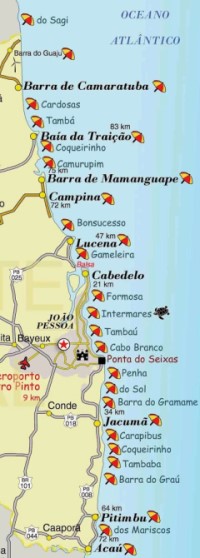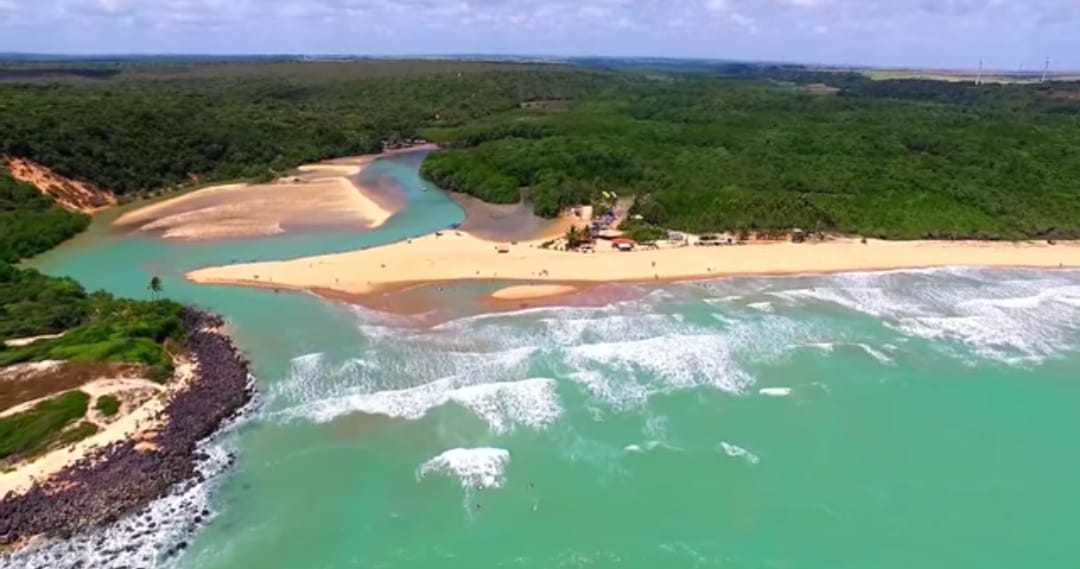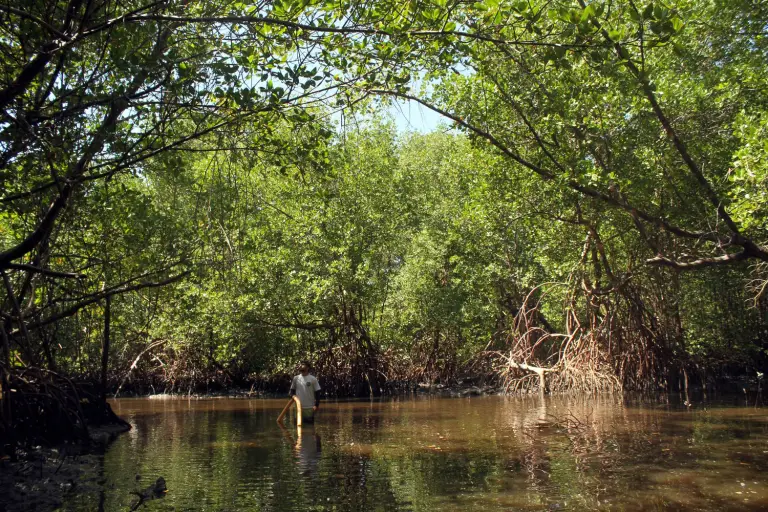Este post também está disponível em:
Português
English

Those who visit the municipality of Mataraca should not miss the Bom Jesus Mother Church, take a walk along the Camaratuba River, take a bath in Lagoa Encantada (a crystal clear water mirror surrounded by mangabeiras), Barra de Camaratuba Beach and visit the Uçá Crab Ecological Park.
One of the most beautiful beaches on the north coast of Paraíba is Barra de Camaratuba. Approximately 11 km from the city, it offers cosy inns and an idyllic landscape, as well as a wonderful bath at the mouth of the Camaratuba River.
One of the attractions that enchant tourists is the meeting of the waters of the Camaratuba River with the sea. At low tide, you can cross the mouth on foot and visit the beaches of the indigenous reserve in the region.
Barra de Camaratuba also offers a huge mangrove area where it is possible to make ecological tours and walk along the Camaratuba River.
Ecological trails are also part of the main activities offered to visitors. One of them is the ‘Caranguejo-Uçá Ecological Park Trail’ which starts inside the mangrove and runs along a part of the Camaratuba River and the tour ends at the sea.
The municipality of Mataraca in Paraíba extends over 184.3 km² and had 8,434 inhabitants at the last census. The demographic density is 45.8 inhabitants per km² in the territory of the municipality.
Neighbouring the municipalities of Baía da Traição, Canguaretama, and Rio Tinto, Mataraca is situated 23 km north-east of Rio Tinto, the largest nearby city.
Mataraca is 118 km from João Pessoa – PB and 123 km from Natal -RN.
History of Mataraca PB
Mataraca had its history always linked to Mamanguape, of which it was part. He participated in its heyday when Mamanguape was the centre of commerce in the state. It all begins with the installation of “Sítio Mataraca”, which was a major producer of sugar cane and cotton.
Tourist attractions of Mataraca PB

See also Tourism Guide of the Baía da Traição
1. Parish of Senhor Bom Jesus


The Parish of Senhor Bom Jesus, with its seat in the municipality of Mataraca, was erected on 18 April 1994, by the then Archbishop of Paraíba D. José Maria Pires.
.
Having as territory all the municipality of Mataraca, with its current limits and parts of the municipalities of Mamanguape and Rio Tinto.
It is said that in the middle of the 18th century the first chapel was built with the help of a missionary nun and was located in the same place as the present Matriz.
And that the religious devotion to Bom Jesus se Mataraca was due to the miracle that Mr Francisco (a well-known man in the region, a practising Catholic, part of the brotherhood of the Heart of Jesus) experienced through the intercession of Bom Jesus.
.
2. Barra de Camaratuba

Located in the municipality of Mataraca, 110 km from João Pessoa and very close to the border with Rio Grande do Norte, this fishing village is considered the last district of the northern coast of the state and boasts attractions such as beaches with a strip of sand that marks the limits between the sea and the river, walks through lagoons, trails inside a mangrove and visits to indigenous communities.
The beach, which has high tide and “brava”, is known for having one of the best peaks for surfing and kitesurfing in Paraiba.
The place has hosted several national championships of the sports and offers classes to visitors.
The Barra de Camaratuba is located at the northern end of the Baia da Traição and, therefore, has characteristics of the dunes that are typically found in Rio Grande do Norte.
3. Guaju River
4. Lagoa Encantada

One of the main attractions of the region is the Lagoa Encantada, much sought after by tourists for its beauty.
The lagoon has practically transparent waters, which are ideal for bathing and, together with the preserved nature that surrounds it, gives the place a special charm. To get there, you need to take the trails of the cliffs of Cardosas, in a light walk of approximately one hour.
5. Ecological Park of the Crab-Uçá
Created by Ivan Burity, president of the NGO SOS Caranguejo Uçá, it is a project to raise ecological awareness and preserve this endangered species.
According to IB-USP (Institute of Biosciences of the University of São Paulo), Brazil is home to more than 10,000 km² of mangrove forests between Amapá and Santa Catarina, one of the largest extensions of this ecosystem in the world.
Poor in vegetation but rich in nutrients, the mangrove is an ideal breeding ground for marine and terrestrial species, giving rise to more than 95 per cent of the food that humans find in the sea.
6. Uçá Crab Trail
.Considered one of the wildest stretches of Paraíba, Barra do Camaratuba is located in the extreme north of the state and is the address of the Uçá Crab Trail, a walk that begins in shallow mangrove waters, follows the river current and ends at the mouth of the Camaratuba, right on the beach.
It’s about 3 kilometres of trail, much of it floating in waters that reach up to six metres deep and winding through dense forests of aerial roots that launch themselves over soggy soil.

And we only see the next landscape at the next turn. Meanwhile, the mangrove fills up and an unknown Paraíba passes before our eyes.
Soon the mangrove meets the Camaratuba River, whose waters leave the tourist on sandbanks that form in front of the beach, where natural pools form at the edge of the sea.
Because it is easy to get lost in the channels that open up along the trail, it is essential to hire a guide who knows the route.
The direction of the trail, from the mangrove to the sea or in the opposite direction, depends on the tide, so there is no fixed time to take the tour.
7. Barra da Boca Beach
Where the waters of the Camaratuba River meet the sea, Boca da Barra is the beach most frequented by bathers in Barra de Camaratuba.

The beach, at low tide, is a great resort, with lifeguards who give the necessary information to those who like a river bath and ensure the tranquility of bathers.
The beach has two kiosks with bar and restaurant services.
The place also favours surfing almost all year round, with the best period being from January to March.
For Kitesurfing, the best period is from March to October, when the predominant and most intense wind is from the Southeast.




















